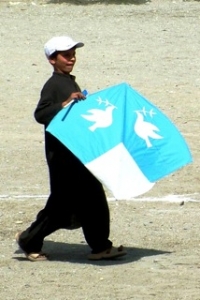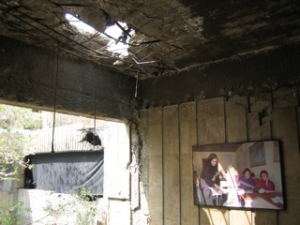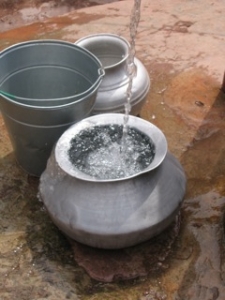Project Description
10 April 2014
by Dr. Daria Davitti
Dr. Davitti is a lecturer in Law at Keele University (d.davitti@keele.ac.uk). From 2006-2009 she worked in Afghanistan, first with the Danish Committee for Afghan Refugees (‘DACAAR’) as a Monitoring and Evaluation officer and as a Gender Consultant; then with the UN Assistance Mission in Afghanistan (‘UNAMA’) as a human rights field officer. Dr. Davitti’s current research focuses on the interplay between international investment law and international human rights law in conflict countries.
The case of Afghanistan is emblematic of countries in the throes of armed conflict,[1] in which both human rights and investment present significant protection challenges. Lack of resources and government capacity, fluctuating commitment of the international community, and collapse of the policing and judicial systems are but some of the challenging characteristics of the volatile Afghan context. As outlined in this snapshot, as much as investment is needed in Afghanistan to restore and improve peoples’ access to basic services and improve standards of living, investment can also pose significant risks to people. At the same time, the country’s extreme context presents some significant challenges to the protection of foreign investments.[2]
Afghanistan has an estimated population of 31.11 million,[3] with an approximately equal distribution between men and women, and the majority of the population below the age of 24.[4] With 36 per cent of its population unable to meet basic survival needs, Afghanistan remains one of the poorest countries in the world.[5] According to the United Nations Development Programme’s (‘UNDP’) multi-dimensional poverty index, which considers deprivation from the perspective of health, education and standard of living, as much as 84 per cent of Afghanistan’s households are multi-dimensionally poor.[6] Access to potable water is problematic for both rural and urban Afghans. The country ranks the lowest in the world for access to an improved water resource, with only 27 per cent of the population having such access.[7]
Afghanistan’s dire situation is further exacerbated by a protracted armed conflict that stretches over more than three decades. After the ousting of the Taliban from power in 2001, the opportunity to shape a more transparent and participatory Afghanistan was missed by the State-building project of the Bonn Agreement. Crucially, the Bonn Agreement failed to address the need for accountability for past violations. As observed by Niland,
… a handful of power-brokers responsible for acts that could be classified as war crimes were antagonistic to any reckoning with the past. A draft paragraph forbidding an amnesty for war crimes was deleted in the final negotiation session in Bonn. This in effect meant that a de facto amnesty was established, making it extremely difficult to counter impunity. It also meant that it would be extremely difficult to ensure that power would not be usurped by those best known for their infamous deeds.[8]
The institutionalisation of abusive power structures that emerged from Bonn has become entrenched over thirteen years, and continues to represent one of the major drivers of the insurgency.[9] Afghanistan, in fact, continues to struggle with a resurgent neo-Taliban and a government that turns a blind eye to those benefiting from positions of influence and power, in an overall climate of impunity:
Injustices and grievances run the gamut from the seizure of personal land, through bribes for government services, to selective poppy eradication that favours some and disadvantages others. A strong feeling of being wronged is associated with the manipulation and marginalization of particular tribes to their political and economic disadvantage. Arbitrary detention, including that which is conflict-related, is a source of great dismay and unhappiness; powerful commanders and those with personal animosities can manipulate dysfunctional systems to have rivals imprisoned.[10]
Whilst most of the international attention on Afghanistan currently revolves around the aftermath of the recent presidential elections and the incumbent ‘transition’, including the withdrawal of most international military forces and aid by the end of 2014, the Afghan government and international donors are focusing their latest efforts in attracting foreign investment, especially in the extractive sector.[11] According to a 2012 World Bank report, Afghanistan will face a persistent financing gap post-2014, mainly due to the country’s high aid dependency.[12] Worse still, foreign aid has been ‘linked to corruption, fragmented and parallel delivery systems, poor aid effectiveness, and weakened governance’.[13] According to the same report, the success of the ‘transition’ is conditional on ‘a reconciliation process, cessation of hostilities, and ultimately a peace agreement with the Taliban’. Otherwise, it will largely involve ‘an international drawdown of military forces and declining aid in the absence of any peace agreement’.[14] With much uncertainty on what the future brings for Afghanistan,[15] its focus on attracting much-needed investment is unsurprising. However, the efforts have not always been channelled into attracting the right type of investor—those able to contribute to general economic and human development in the country, and also to respect the human rights of those impacted by investment activities.
Key investment and human rights issues
The booming Afghan extractive sector offers a good example of the challenges involved in ensuring both investment and human rights are protected. In 2007, for instance, Afghanistan agreed a 30-year lease for the exploitation of the Aynak site—one of the largest copper deposits in the world. The public tender was amply criticised for being flawed and corrupt.[16] According to independent reports,[17] local communities were not meaningfully involved as relevant stakeholders. Despite disclosure commitments by the Ministry of Mines and Petroleum (‘MoMP’),[18] the full terms of the mining contract and its related sub-contracts still remain unavailable to the public.[19] In the last few years, attacks by non-State armed groups against the Aynak site have increased, eventually leading to project delays and renegotiations of the contract.[20] The local community has also grown increasingly dissatisfied with various aspects of the project such as the resettlement compensation offered by MoMP, the effect of drilling on water levels, impeded access to agricultural and grazing land and the limited employment opportunities for Afghan workers.[21] In various areas of Afghanistan, tensions over land and water have deep historical roots, usually involving local communities, armed power-holders and returning displaced persons. In the area surrounding Aynak, the resettlement needs of over 100 households from villages affected by the project have fuelled these tensions as well as built support for armed insurgency.[22]
Afghanistan’s weak adherence to international human rights standards increases investors’ risks of becoming involved with adverse human rights impacts, either by causing them, contributing to them or being linked to them through their operations.[23] Scarce State protection for the environment, for instance, translates into an almost non-existent regulatory framework capable of protecting the Afghan population from the types of pollution and contamination linked with poor management of environmentally risky sectors (such as the extractive sector). The direct effects of pollution and contamination on people’s health and livelihoods are also compounded by increased pressures on scant water resources: generally speaking domestic water use, necessary for human survival, competes with agricultural and industrial use.[24] The Afghan government, eager to attract investment, may be prone to prioritise agricultural and industrial water users, to the detriment of domestic users. Water scarcity, therefore, when it occurs, is mainly the result of unequal allocation of water, and is ‘rooted in power, poverty and inequality, not in physical availability’.[25]
The situation of increasing insecurity also sees foreign investors required to employ private military and security companies, whose behaviour over the past decade has resulted in their gradual ban from operating in the country.[26] Concerns over unacceptable labour conditions, restrictions to freedom of expression and the lack of State protection for human rights defenders have been amply reported by the United Nations Assistance Mission in Afghanistan (‘UNAMA’).[27] Repressive State intervention may escalate in the context of demonstration of dissent by local communities towards investment projects: the sudden explosion of mob violence is not uncommon in Afghanistan, nor is the brutal resort to force by State actors in order to suppress it.[28]
Over the last decade, business opportunities have been mainly linked to the reconstruction of the country’s infrastructure and to the security economy, in support of the national police forces and of the national and international army. Historically, the agricultural sector is one of the main exporting sectors (mainly nuts, dried fruits and seeds, without considering opium exports), with significant future opportunities for those willing to invest in appropriate storage facilities and food processing infrastructures. The service sector has increased significantly in the last six years, especially in telecommunications, finance and insurance, and information technology, all mainly related to the international presence in the country.[29]
Looking at the future, however, hopes and fears seem to focus almost exclusively on increased investment in the extractive sector,[30] despite the unstable context described so far.[31] It is apparent that Afghanistan’s failure to attract the right type of investors may result in the country’s further collapse, not least in human rights protection terms. In Afghanistan it is necessary to build on the UN Framework for Business and Human Rights and related Guiding Principles,[32] whilst at the same time acknowledging the need for more elaborated solutions appropriate for the country’s complexity. In particular, we must acknowledge the need for investors to receive more support and guidance from home States, not least through the creation of appropriate regulatory frameworks.[33] When considering the specific context of conflict countries, the commentary to UN Guiding Principle 7 indicates that home States have a greater role to play:
[Home] States should warn business enterprises of the heightened risk of being involved with gross abuses of human rights in conflict-affected areas. They should review whether their policies, legislation, regulations and enforcement measures effectively address this heightened risk, including through provisions for human rights due diligence by business. Where they identify gaps, States should take appropriate steps to address them. This may include exploring civil, administrative or criminal liability for enterprises domiciled or operating in their territory and/or jurisdiction that commit or contribute to gross human rights abuses. Moreover, States should consider multilateral approaches to prevent and address such acts, as well as support effective collective initiatives.[34]
For investors, doing business while respecting human rights in Afghanistan means understanding the actual and potential impacts of their activities, products and services on the rights of people within the multi-layered complexities that the country presents. It is however equally important that other key actors, such as States, recognise that corporate due diligence alone will not suffice to meet the challenges that investors will face. The case of Afghanistan clearly shows the need for fulfilling the (host and home) State duty to protect human rights in conflict countries through multilateral action, so that standards can be set across the board and appropriate policies adopted, without creating unfair disadvantages.[35]
In this brief paper I have flagged only some of the human rights that are likely to be affected by the arrival of foreign investors in Afghanistan’s complex environment. The development of effective and comprehensive human rights policies and processes adapted to the complexities of the Afghan context presents apparent challenges, but their significance cannot be underestimated. They are crucial to fulfil the State duty to protect and the investor’s responsibility to respect human rights, as well as to ensure Afghanistan’s long-term economic and human development.
[1] Although many commentators in the past decade have depicted Afghanistan as a post-conflict country, in this article I take the view that Afghanistan is involved in a protracted armed conflict which continued unabated after the 2001 intervention. This view is also shared by most humanitarian organisations operating in Afghanistan.
[2] R Davis, ‘The UN Guiding Principles on Business and Human Rights and Conflict-Affected Areas: State Obligations and Business Responsibilities’ (2012) 94 International Review of the Red Cross 961, 973–74.
[3] The first plan for a national census in Afghanistan was abandoned in 2008, in advance of the previous round of presidential elections. This was partly because some areas of the country remained inaccessible due to the escalating armed conflict, partly due to strategic positioning by the competing political parties. See ‘Afghan census cancelled due to security fears’, The Guardian, Wednesday 11 June 2008, at http://www.theguardian.com/world/2008/jun/11/afghanistan.internationalaidanddevelopment (last viewed 23 January 2014).
[4] According to 2013 estimates, 42.6 per cent of the population is between 0-14 years, and 21.9 per cent between 15-24 years. See Afghanistan Demographics Profile 2013, available at http://www.indexmundi.com/afghanistan/demographics_profile.html (last viewed 23 January 2014).
[5] This percentage corresponds to approximately 9 million people. See Centre for Policy and Human Development (CPHD), Afghanistan Human Development Report 2011 – The Forgotten Front: Water Security and the Crisis in Sanitation (CPHD, 2011) 3.
[6] ibid.
[7] ibid, 10.
[8] N Niland, ‘Impunity and Insurgency: A Deadly Combination in Afghanistan’ (2010) 880 International Review of the Red Cross 931, 934.
[9] ibid, 940.
[10] ibid, 941.
[11] See in the general the efforts by the Afghan Ministry of Mines and Petroleum at http://mom.gov.af/en (last viewed 11 January 2014). These efforts are backed by The World Bank : see e.g. The World Bank, The Afghanistan Mining Sector as a Driver of Sustainable Growth: Benefits and Opportunities of Large-Scale Mining (World Bank, 2011).
[12] In 2010/2011 foreign aid amounted to USD 15.7 billion, equal to the country’s total GDP. The World Bank, Afghanistan in Transition: Looking Beyond 2014 (2012) volume 1, iv.
[13] ibid.
[14] ibid, volume 2, 4.
[15] M van Bijlert, ‘Fear, Hope and Determination: Afghanistan and the 2014 Syndrome’, Afghanistan Analysts Network, 10 January 2014, available at http://www.afghanistan-analysts.org, last viewed 11 January 2014.
[16] The lease was awarded to the Metallurgical Corporation of China (MCC) which then created the Afghan-based entity MJAM). For allegations of corruption and bribery during the tender, see the report by one of the former consultants to the then Ministry of Mines and Industry: J R Yeager, ‘The Aynak Copper Tender: Implications for Afghanistan and the West’ (2009), available at www.cimicweb.org, last viewed 11 January 2014. All allegations are firmly rejected by the Afghan Ministry of Mines and Petroleum, including on its official website.
[17] See Global Witness, ‘Copper Bottomed? Bolstering the Aynak Contract: Afghanistan’s First Major Mining Deal’ (2012), 28–29. The MoMP disagrees with this view, and its website now hosts a special section on the Aynak project, including in relation to an Aynak Compliance Monitoring Project. See http://mom.gov.af/en/page/5962, last viewed 11 January 2012.
[18] Global Witness, note 17 above.
[19] On transparency and the significance of disclosure of contract terms, see UN Human Rights Council, ‘Principles for Responsible Contracts: Integrating the Management of Human Rights Risks into State-Investor Contract Negotiations: Guidance for Negotiators’ (25 May 2011) UN Doc A/HRC/17/31/Add.3, Principle 10 and paras 60–64.
[20] It is important to note that project delays were also due to the discovery, on the mining area, of one of the most significant and comprehensive archeological sites in the world, called Mes Aynak. The site dates back to the Bronze Age (3000 B.C.E.) and comprises an ancient Buddhist monastic complex, city, temples, etc. For more information, see Alliance for the Restoration of Culture Heritage (ARCH) at www.archinternational.org/mes_aynak.html, last viewed 11 January 2014.
[21] S Lakhani, ‘Extractive Industries and Peacebuilding in Afghanistan: The Role of Social Accountability’ (United States Institute of Peace, 2013), 4–5.
[22] ibid. See also Global Witness, note 17 above, 28.
[23] R Davis, note 2 above, 973–74.
[24] World Water Assessment Programme, United Nations World Water Development Report 3: Water in a Changing World (Earthscan and United Nations Educational, Scientific and Cultural Organization, 2009) 99.
[25] United Nations Development Program, Human Development Report 2006, Beyond Scarcity: Power, Poverty and the Global Water Crisis (Palgrave Macmillan, 2006) 2.
[26] The decision was taken by President Hamid Karzai with Presidential Decree 62 in August 2010. See E Holland, ‘Afghanistan’s Ban on Private Security Companies: What Are the Risks for Private Investors?’, Foley Hoag LLP, April 2012, at www.csrandthelaw.com, last viewed 11 January 2014.
[27] See e.g. N Mobarez, ‘Declaration on Freedom of Expression in Afghanistan’ (UNAMA 2009); and ‘Silence is Violence: End Violence Against Women in Afghanistan’ (UNAMA 2009), both available at http://unama.unmissions.org, last viewed 11 January 2014.
[28] See e.g. ‘Postcard from Kabul: Rampage Shines Light on Afghan Prison Conditions, Spiegel Online International, 7 March 2006.
[29] US & Foreign Commercial Service and US Department of State, ‘Doing Business in Afghanistan: 2013 Country Commercial Guide for US Companies’, available at http://www.trade.gov/afghanistan/static/2013%20CCG%20Afghanistan_Latest_tg_aftf_004071.pdf (last viewed 23 January 2014).
[30] With the support of the World Bank and of the UK Department for International Development (DFID), Afghanistan aims to obtain compliance status in the Extractive Industries Transparency Initiative (EITI) by the end of 2014. See ‘Doing Business in Afghanistan’, note 29 above.
[31] Major extractive contracts have so far been granted, inter alia, to Chinese, Indian and Canadian extractive companies. See in general the websites of the Ministry of Mines and Petroleum at www.mom.gov.af.
[32] UN Human Rights Council, ‘Guiding Principles on Business and Human Rights: Implementing the United Nations “Protect, Respect and Remedy” Framework’ (21 March 2011) UN Doc A/HRC/17/31.
[33] For an analysis of whether home states are under an obligation to regulate corporate activities abroad, see O De Schutter et al, ‘Commentary to the Maastricht Principles on Extra-Territorial Obligations of States in the area of Economic, Social and Cultural Rights’ (2012) 34 Human Rights Quarterly 1084.
[34] Guiding Principles, note 32 above, 11 (author’s emphasis).
[35] UN Human Rights Council, ‘Business and Human Rights in Conflict-Affected Regions: Challenges and Options Towards State Responses’ (27 May 2011) UN Doc A/HRC/17/32, para 21.




